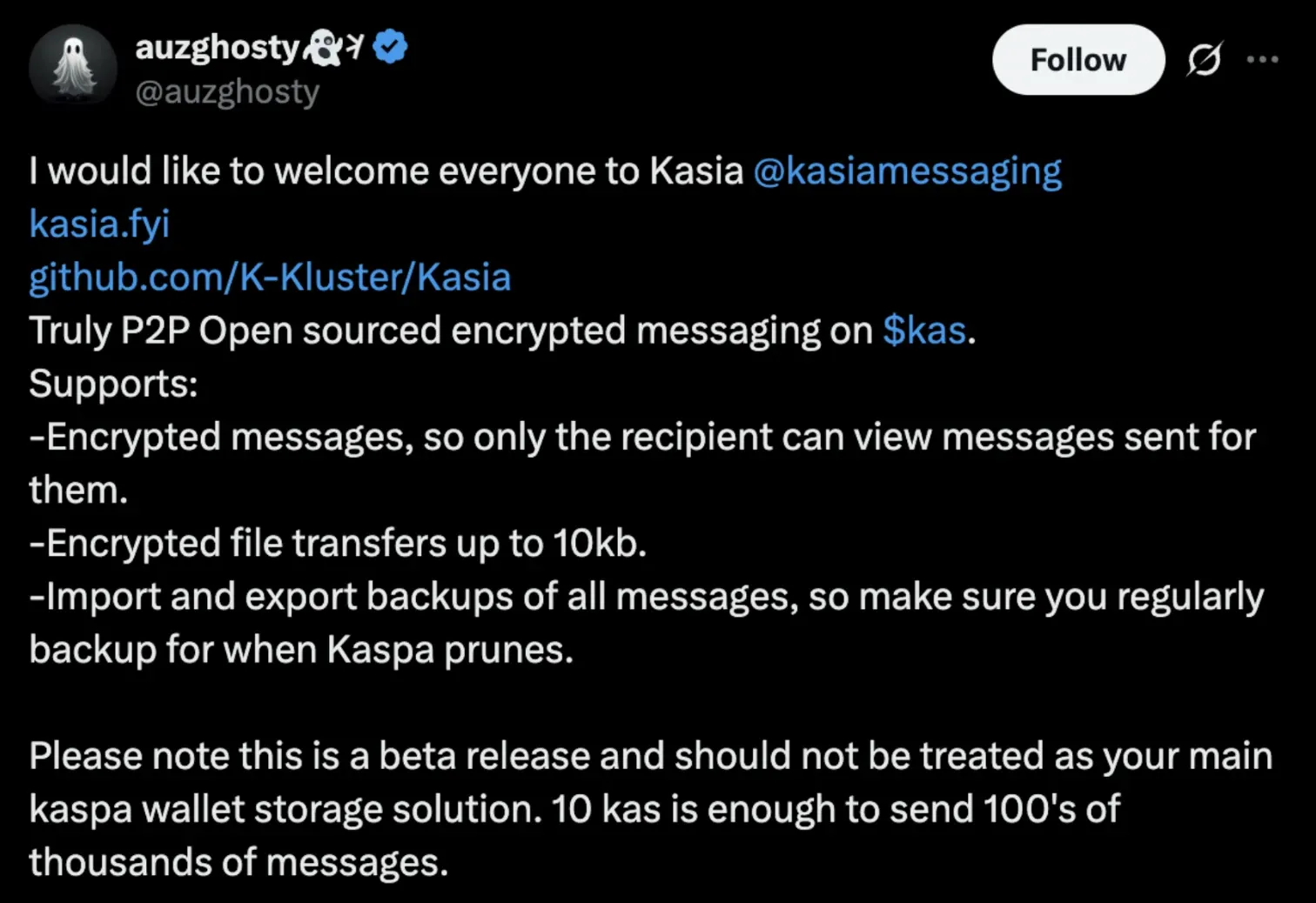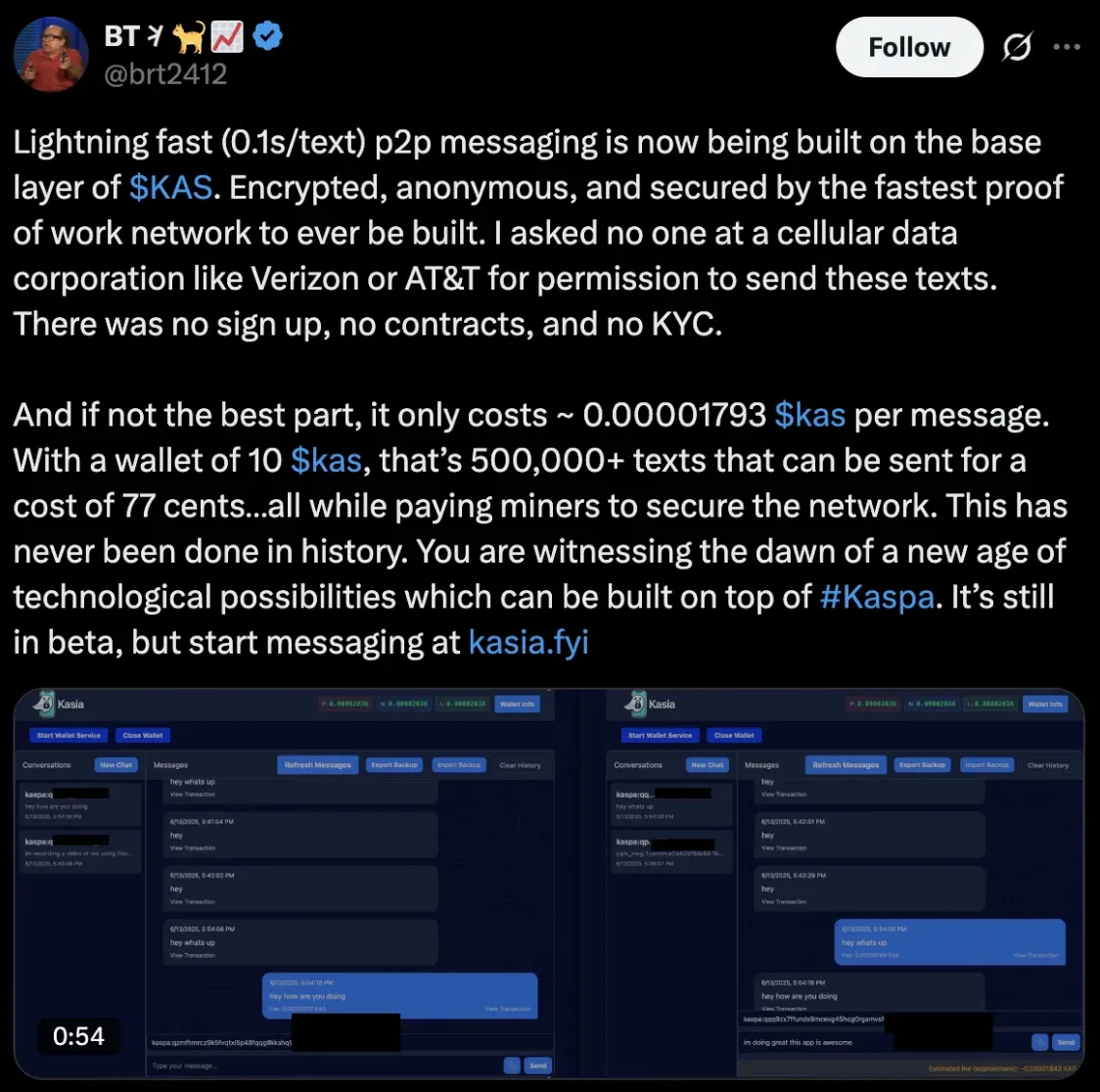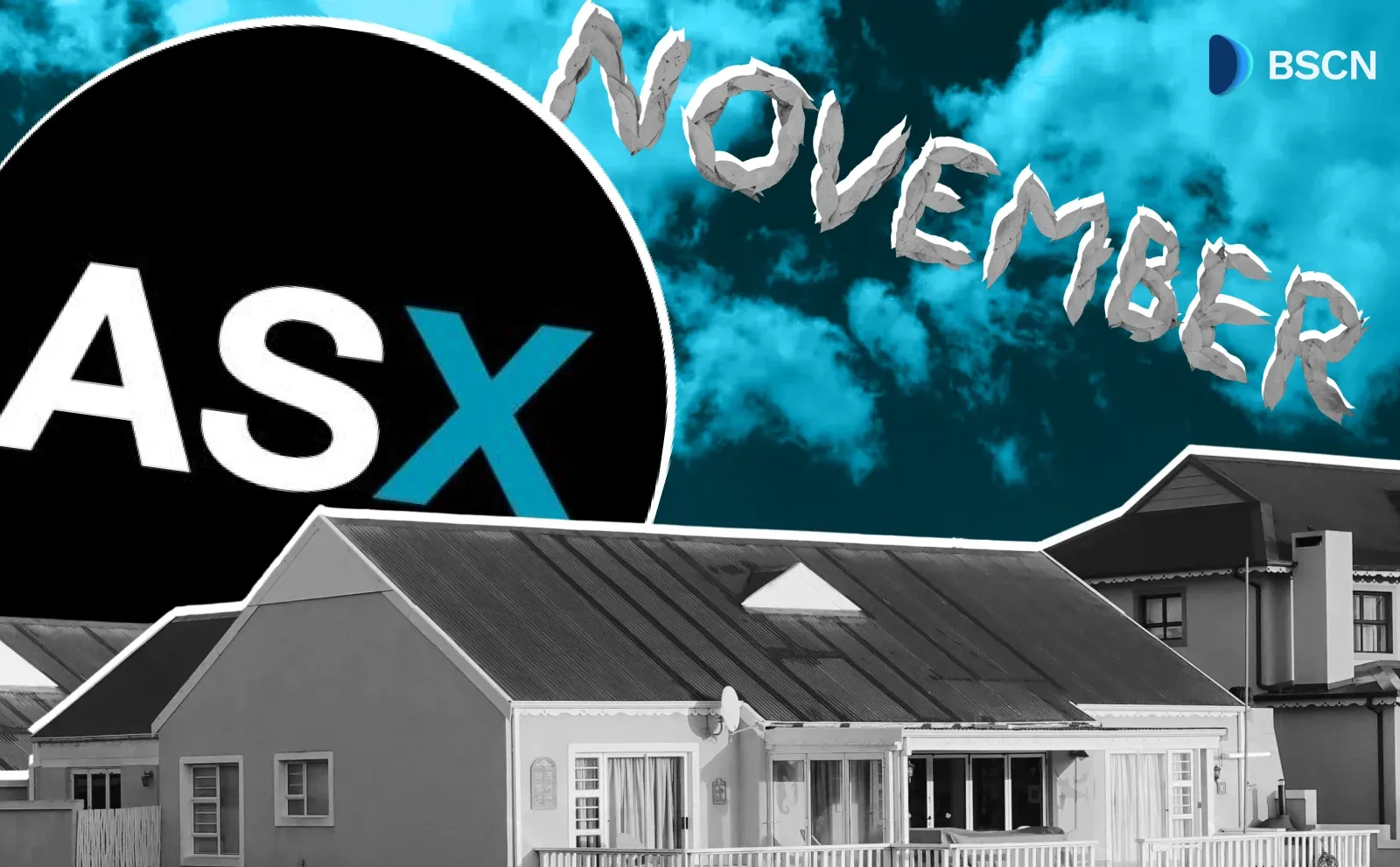Deepdive
(Advertisement)
Unveiling Kasia: A New Encrypted Messaging System Built on Kaspa

Kaspa's leading community account has just highlighted a fascinating new P2P messaging app, leveraging the L1's scalability - Meet Kasia.
UC Hope
June 17, 2025
(Advertisement)
Table of Contents
On June 17, Kaspa City, the leading community X account for Kaspa, shared exciting news about a new development within its blockchain ecosystem. The post introduced Kasia, a fully encrypted peer-to-peer (P2P) messaging system built on the Kaspa blockchain. The open-source project, led by developer @auzghosty, aims to expand Kaspa’s utility beyond financial transactions, potentially positioning it as a widely used proof-of-work (PoW) blockchain. However, as a new and untested product, users are advised to exercise caution when exploring Kasia.
Kaspa, a blockchain platform known for its high scalability and rapid block times, operates on the innovative GHOSTDAG protocol. This technology allows the network to process 10 blocks per second, with plans to scale to 100 blocks per second, making it an ideal platform for applications like Kasia. The latest development has sparked interest among the Kaspa community, with discussions unfolding across social media, particularly X.
What is Kasia? Understanding the New Messaging System
Kasia is designed as a decentralized, private P2P messaging platform that leverages the Kaspa blockchain’s infrastructure. According to the Kaspa City X post, Kasia enables users to send encrypted messages without relying on centralized servers, a feature that sets it apart from traditional messaging apps like WhatsApp or Telegram. The project is currently in its beta phase, meaning it is still under development and subject to potential improvements.

To use Kasia, users need to set up a Kaspa wallet and fund it with at least 10 KAS, the native cryptocurrency of the Kaspa network. Each message sent through Kasia is recorded as a Layer 1 transaction, incurring a minimal fee of approximately 0.00001791 $KAS. This low cost allows users to send over 500,000 messages with a 10 KAS wallet, translating to a cost of about $0.74 based on current market data, per CoinMarketCap.
How Kasia Works: Technical Details and User Experience
Kasia’s functionality hinges on Kaspa’s blockDAG (Directed Acyclic Graph) architecture, which differs from traditional blockchains by allowing parallel blocks to coexist. This is enabled by the GHOSTDAG protocol, a consensus mechanism that ensures secure and efficient transaction ordering. The network’s current block rate of 10 blocks per second, combined with a one-second confirmation time, supports Kasia’s real-time messaging capabilities.
Users can access the Kasia beta through a link provided in the Kaspa City X post. Additionally, instructions for running Kasia locally are available, appealing to tech-savvy users and developers. The process involves setting up a Kaspa wallet via platforms like https://wallet.kaspanet.io/, funding it, and initiating chats using a handshake system that includes a refundable 0.2 KAS fee.
“To start a conversation with another user you need to create a "handshake" these handshake messages will cost 0.2 kas + fees but if they/you accept 0.2 kas will be returned in the response. After the Handshake messages only cost transaction fees based off your message length,” auzghosty X post read.
X posts from community members highlight Kasia’s user-friendly aspects, such as its lack of sign-up requirements, contracts, or Know Your Customer (KYC) processes. However, as a new and untested product, users should be mindful of potential bugs or security gaps during this early stage.

Privacy and Security Features of Kasia
Privacy is a cornerstone of Kasia’s design. The system employs encryption to ensure that only the intended recipient can access messages, a point emphasized by @auzghosty in an X post on June 13, 2025. The decentralized nature of the Kaspa blockchain eliminates reliance on centralized servers, reducing the risk of censorship, surveillance, or downtime.
This privacy focus positions Kasia as an alternative to cellular messaging services that require KYC data and charge higher fees. However, given its beta status, the system’s security features are still being refined, and users are encouraged to provide feedback to @auzghosty to address any vulnerabilities.
Comparison with Existing Messaging Solutions
Compared to mainstream messaging apps, Kasia offers unique advantages. Traditional platforms rely on centralized servers, which can be vulnerable to hacking or government oversight. Blockchain-based alternatives, such as those on Ethereum, often incur higher transaction fees due to network congestion. Kasia’s pricing model undercuts these competitors significantly.
However, Kasia currently lacks features like group chats or support for large multimedia files, with a 10KB file transfer limit. As a new and untested product, it may not yet match the maturity of established apps, but its decentralized approach appeals to privacy advocates and crypto enthusiasts.
Future Prospects and Limitations
Kasia’s future depends on user adoption and technical enhancements. Potential upgrades could include larger file transfers or group messaging, addressing current limitations. The Kaspa network’s scalability, supported by its pruning strategy to maintain a compact blockDAG, suggests it can handle increased messaging volume.
As a new and untested product, Kasia faces challenges. Its beta status means it may encounter stability issues or security risks, requiring cautious use. The project’s success will also hinge on attracting developers and users beyond the current Kaspa community.
Interested users can explore Kasia by visiting the beta link in the Kaspa City X post and also verify its functionality. Setting up a Kaspa wallet and funding it with 10 KAS is the first step. For technical users, running Kasia locally offers a hands-on experience, fostering community-driven development.
Conclusion
Kasia represents a bold step forward for the Kaspa blockchain, introducing a decentralized messaging system that prioritizes privacy and low costs. While its beta status and untested nature call for caution, the project’s potential could strengthen Kaspa’s position in the crypto market.
As the community continues to test and refine Kasia, it may pave the way for new applications, solidifying Kaspa’s reputation as a scalable, innovative blockchain.
Read Next...
Disclaimer
Disclaimer: The views expressed in this article do not necessarily represent the views of BSCN. The information provided in this article is for educational and entertainment purposes only and should not be construed as investment advice, or advice of any kind. BSCN assumes no responsibility for any investment decisions made based on the information provided in this article. If you believe that the article should be amended, please reach out to the BSCN team by emailing [email protected].
Author
 UC Hope
UC HopeUC holds a bachelor’s degree in Physics and has been a crypto researcher since 2020. UC was a professional writer before entering the cryptocurrency industry, but was drawn to blockchain technology by its high potential. UC has written for the likes of Cryptopolitan, as well as BSCN. He has a wide area of expertise, covering centralized and decentralized finance, as well as altcoins.
(Advertisement)
Latest News
(Advertisement)
Crypto Project & Token Reviews
Project & Token Reviews
Comprehensive reviews of crypto's most interesting projects and assets
Learn about the hottest projects & tokens
Latest Crypto News
Get up to date with the latest crypto news stories and events














